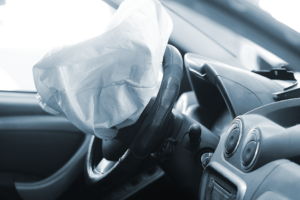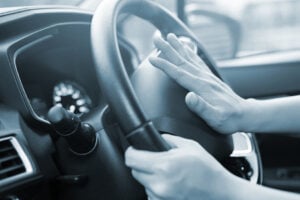What Safety Features Are Required by Law in Utah Cars?
In recent years, safety technology in new cars has advanced by leaps and bounds. Since seat belts were first mandated in 1968, automakers have introduced technology that can help drivers steer, accelerate, and brake. In fact, many of these features are now required in new vehicles.
We’ll go over car safety features available in today’s market and outline which ones are required in new motor vehicles.
Airbags
Required since 1999, side and front airbags are one of the most well-known vehicle safety features. According to the Insurance Institute for Highway Safety (IIHS), it is estimated that frontal airbags reduce fatalities by around 30%. Side airbags are even more effective, reducing driver fatalities by 37% in sedans and 52% in SUVs.
Seatbelts
Safety belts were invented for airplanes in the late 1800s. It wasn’t until the mid-20th century that the 3-point seatbelt came around. By 1968, government mandate required that all new vehicles have seatbelts, though vehicle occupants were not required to wear them.
Utah’s seatbelt law became a primary enforcement law in 2015. This means that you can be pulled over simply for not wearing your seatbelt.
Nearly half of people who die in car accidents in Utah are unbuckled–this is a concerning statistic, since it is estimated that 86% of Utahns wear their seatbelts regularly.
The National Highway Traffic Safety Administration (NHTSA) has found that serious injuries and fatalities could be reduced by up to 50% with proper and consistent use of seatbelts.
Horn
Though today, the sound of a beeping horn is often associated with frustration or anger, it is, of course, an important safety feature. Horns have been included in motor vehicles for more than 100 years–in the days before light-controlled intersections, they were a polite way to alert pedestrians to an oncoming car.
Headlights, Taillights, Brake Lights, and Turn Signals
Automotive lights became federally regulated in the 1960s, with the passage of the Motor Vehicle Safety Act of 1966 and the formation of the NHTSA. The type of lightbulbs used, however, has changed many times since they became standard equipment.
On today’s roads, you’re likely to see LED or HID lights on new models of cars. These types of lightbulbs are brighter and have longer lifespans than the older halogen bulbs, which were standard in the 1970s.
Tire Pressure Monitoring System
Tire blowouts are potentially catastrophic events, particularly when traveling at high speeds. Your car’s tire pressure monitoring system serves to prevent blowouts by alerting you when your tire pressure is too high or low (some cars may only notify you of low tire pressure).
When your tire pressure indicator light turns on, it is a sign that you need to pull over when it’s safe to do so. Check each tire’s pressure for over- or underinflation. Inflate or deflate your tires as needed.
In new models, your car’s computer system may tell you exactly which tire needs attention. It may also tell you the estimated tire pressure in each tire.
Rear View Mirrors
Utah law requires that every motor vehicle is equipped with at least two rear view mirrors. One mirror must be mounted on the driver’s side of the car. The other may either be located on the right side of the vehicle or inside the vehicle (typically seen in the top center of the windshield).
Backup Cameras
As of May 1, 2018, backup cameras are required on any new vehicles in the United States. Prior to the advent of the backup camera, pedestrians, especially children, were often put at risk when cars reversed. This is especially true of higher-profile vehicles, like SUVs and pickup trucks.
Anti-Lock Braking System
Any vehicle made after 2012 in the US will be equipped with an anti-lock braking system (commonly referred to as ABS). This safety feature works to prevent your wheels from locking while you brake. This helps keep the car from skidding.
If you were ever taught to pump your brakes if your car started to skid, you’ll be familiar with this concept. ABS simply does the pumping for you.
Electronic Stability Control
Along with ABS, electronic stability control has been required in new models since 2012. The purpose of ESC is to prevent the car from skidding in the event of a loss of steering control.
The ESC system in your car monitors where you turn the steering wheel and the direction your vehicle is moving. If it detects that you’ve lost steering control, it takes over the brakes on each wheel to right the vehicle. It also works with the traction control system in your car to adjust your speed.
ESC cannot completely prevent vehicle rollovers, but it can keep your car on the road, greatly reducing the risk of tipping.
Automatic Emergency Braking
The requirement for automatic emergency braking (AEB) is much newer than others on this list. In fact, as of June 2023, the mandate for this advanced safety feature has not yet gone into effect.
The NHTSA announced in May of this year that AEB systems will be required in new cars within three years. This technology is already included in 90% of passenger vehicles on the market.
AEB systems detect hazards on the road in front of you (usually other cars) and slows your car down prior to impact. The goal with the new requirement is to make the technology faster and more accurate, especially where pedestrians are involved.
Other Safety Features that Are not Required
Many passenger vehicles include advanced safety features that are not mandated (yet), but can help immensely in keeping occupants safe.
Lane departure warning and lane keep assist
These features monitor your vehicle’s position in its lane. If you start to drift, the lane departure warning system will alert you. If your vehicle is equipped with lane keep assist, it may take over the steering control briefly to keep you between the lines.
Blind spot detection
Some vehicles include blind spot monitoring. This feature lets you know if a vehicle is traveling in your blind spot (usually by illuminating a light in your side mirror).
Adaptive cruise control
Different from regular cruise control, adaptive cruise control uses sensors to detect the speed of cars in front of you. As you approach a slower-moving car from behind, your adaptive cruise control system will slow down. If the other car moves out of your way, the system will increase your speed back to the pre-set cruising speed.
Forward collision warning
This feature often works in tandem with automatic emergency braking. Instead of taking control of your brakes, however, this system simply alerts you to hazards in front of you, usually with an audible alarm.

